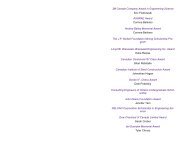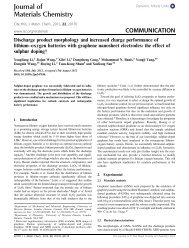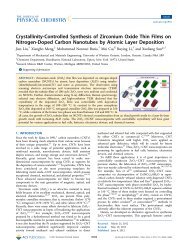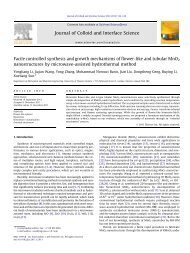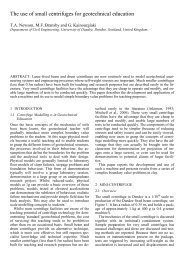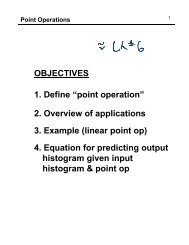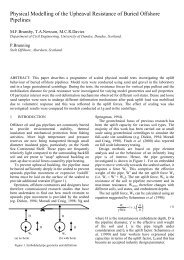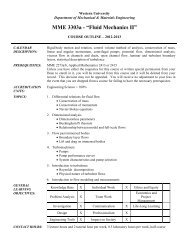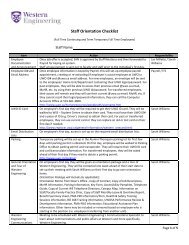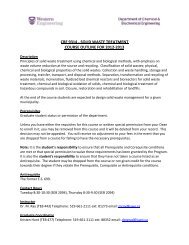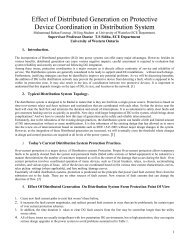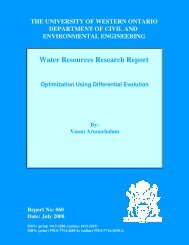Generator Stator Protection, under/over voltage, under /over ...
Generator Stator Protection, under/over voltage, under /over ...
Generator Stator Protection, under/over voltage, under /over ...
Create successful ePaper yourself
Turn your PDF publications into a flip-book with our unique Google optimized e-Paper software.
<strong>Generator</strong> <strong>Stator</strong> <strong>Protection</strong>, <strong>under</strong>/<strong>over</strong> <strong>voltage</strong>, <strong>under</strong> /<strong>over</strong> frequency<br />
and unbalanced loading<br />
By<br />
Ramandeep Kaur Aujla<br />
S.NO 250447392<br />
ES 586b: Theory and applications of protective relays<br />
Department of Electrical and Computer Engineering<br />
The University of Western Ontario<br />
London, Ontario, Canada<br />
May 5,2008<br />
1
TABLE OF CONTENTS<br />
1. Introduction of the stator windings faults………………………………..3<br />
2. <strong>Stator</strong> protection<br />
2.1 Differential protection of the stator windings……… ......3.<br />
2.2 Modified differential protection windings………………..4<br />
2.3 Biased circulating current protection……………………..5<br />
2.4 Self balance protection system……………………………6<br />
2.5 <strong>Generator</strong> ground fault protection…………………….…..7<br />
2.6 <strong>Stator</strong> inter turn fault protection……………………….….8<br />
3. Under/<strong>over</strong> frequency protection…………………………………….........9<br />
4. Under/ <strong>over</strong> <strong>voltage</strong> protection…………………………………………...10<br />
5. <strong>Protection</strong> against the unbalance loading………………………………....10<br />
6. References………………………………………………………….......…11<br />
2
1. INTRODUCTION OF THE STATOR WINDINGS FAULTS:<br />
<strong>Stator</strong> winding faults: These types of faults occur due to the insulation breakdown of the<br />
stator coils. Different types of stator windings faults are:<br />
a) phase to earth fault<br />
b) phase to phase fault<br />
c) inter turn fault<br />
Phase to earth fault are limited by resistance of the neutral grounding resistor. There are<br />
fewer chances for the occurrence of the phase to phase and interturn faults. The insulation<br />
between the two phases is at least twice as thick as the insulation between one coil and<br />
the iron core, so phase to phase fault is less likely to occur. Inter turn fault occurs due the<br />
incoming current surges with steep wave front.<br />
2. STATOR PROTECTION:<br />
2.1 Differential protection for generators: Differential protection is used for<br />
protection of the generator against phase to earth and phase to phase fault. Differential<br />
protection is based on the circulating current principle.<br />
Fig1: Differential protection for generators<br />
3
In this type of protection scheme currents at two ends of the protection system are<br />
compared. Under normal conditions, currents at two ends will be same. But when the<br />
fault occurs, current at one end will be different from the current at the end and this<br />
difference of current is made to flow through relay operating coils. The relays then closes<br />
its contacts and makes the circuit breaker to trip, thus isolate the faulty section. This type<br />
of protection is called the merz price circulating current system.<br />
Limitations of this method: The earth fault is limited by the resistance of the neural<br />
earthing. When the fault occurs near the neutral point, this causes a small current to flow<br />
through the operating coil and it is further reduced by the neutral resistance. Thus this<br />
current is not sufficient to trip the circuit breaker. By this protection scheme , one can<br />
protect only 80 to 85 percent of the stator winding. If the relays with low settings are used<br />
the it will not provide desire stability. This difficulty is <strong>over</strong>come by using the modified<br />
differential protection.<br />
2.2 Modified differential protection: In modified differential protection setting of the<br />
earth faults can be reduced without any effect on the stability.<br />
Fig 2: modified differential protection for the generators<br />
4
In this method two relays are used for the phase to phase fault and one relay is used for<br />
the protection of earth fault. In this method the two relays and the balancing resistance<br />
are connected in star and the phase fault relay is connected between the star point and the<br />
neutral pilot wire. The star connected circuit is symmetrical in terms of impedance. So<br />
when the fault current occurs due to the phase to phase fault, it cancels at the star point<br />
due to the equal impedance. Thus it is possible with this scheme to operate with the<br />
sensitive earth fault relays. Thus this scheme provides protection to the greater<br />
percentage of the stator winding.<br />
2.3 Biased circulating current protection (percentage differential relay protection):<br />
With the differential protection relaying, the CTs at both end of the stator windings must<br />
be same. If there is any difference in the accuracy of the CTs the mal-operation of the<br />
relay will occurs. To <strong>over</strong>come this difficulty, biased circulating current protection is<br />
used. In this protection system we can automatically increase the relay setting in<br />
proportion to the fault current. By suitable proportioning of the ratio of the relay<br />
restraining coil to the relay operating coil any biased can be achieved.<br />
Fig 3 : biased protection of the stator winding<br />
5
Under normal operating condition current in secondary of the line CTs will be same as<br />
the current in the secondary of the CTs at the neutral end. Hence there are balanced<br />
current flows in the restraining coils and no current flows in the operating coil. If there is<br />
any phase to phase or phase to earth fault occurs then it causes the differences in the<br />
secondary current of the two CTs. Thus the current flows through the operating coil and<br />
make the circuit breaker to trip.<br />
Advantages of this method: a) It does not require the CTs with balancing features.<br />
b) It also permit the low fault setting of the relay, thus protects the greater percentage of<br />
the stator winding.<br />
2.4 Self balance protection system: This type of protection is employed for earth fault<br />
and also for the phase to phase fault.<br />
THREE PHASE STAR<br />
CONNECTED<br />
GENERATOR<br />
RELAY<br />
CTs<br />
EARTHING<br />
RESISTANCE<br />
MAIN CIRCUIT<br />
BREAKER<br />
Fig 4 self biasing protection of the stator windings<br />
R<br />
Y<br />
B<br />
6
In this type of protection two cables are required which is connected to the two ends of<br />
the each phase. These two cables are passed through the circular aperature of the ring<br />
type CTs. Under normal conditions the current flowing in the two leads of the cable will<br />
be in the same direction and no magnetisation occurs in the ring type CTs. When the<br />
earth fault occurs in any phase the fault current occurs only once through the CTs and<br />
thus magnetic flux induced, this induces the emf in the relay circuit causes the circuit<br />
breaker to trip.<br />
This is very sensitive type earth fault protection but it also have some limitations:<br />
a) a different design of the cable lead is required in this scheme.<br />
b) large electromagnetic forces are develop in the CT ring <strong>under</strong> the condition of heavy<br />
short circuit.<br />
2.5 <strong>Stator</strong> ground fault protection: The method of grounding effect the degree of<br />
protection which is employed by the differential protection. High impedance reduces the<br />
fault current and thus it is very difficult to detect the high impedance faults. So the<br />
differential protection does not work for the high impedance grounding. The separate<br />
relay to the ground neutral provides the sensitive protection. But ground relay can also<br />
detect the fault beyond the generator, it the time co-ordination is necessary to <strong>over</strong> come<br />
this difficulty.<br />
If we use the star- delta transformer bank, then it will block the flow of ground<br />
currents, thus preventing the occurrence of the fault on other side of the bank from<br />
operating ground relays. In unit protection scheme the transformer bank limits the<br />
operation of the fault relay to the generator.<br />
Unit connected schemes: In this scheme high resistance grounding is used and system<br />
is grounded through the transformer bank and through the resistors.<br />
95% scheme: Relay which uses in the unit connected schemes must be insensitive to the<br />
normal third harmonics <strong>voltage</strong> that may be present between the neutral and the ground,<br />
and it must be sensitive to the fundamental harmonics <strong>voltage</strong> that is the cause of the<br />
fault. The magnitude of the neutral shift depends upon its location in the winding of the<br />
ground fault. And the general choice of the relay sensitive and distribution transformer<br />
<strong>voltage</strong> provide 95% protection of the winding so this scheme is called 95% scheme.<br />
Neutral third harmonic <strong>under</strong> <strong>voltage</strong>: There is the third harmonic present between the<br />
neutral and the ground , and other schemes takes advantages of this and respond to the<br />
<strong>under</strong> <strong>voltage</strong> between the neutral and the ground.<br />
100% scheme: This scheme provides complete protection of the stator winding by<br />
injecting the signal between the stator winding and monitors it for change. 95% scheme<br />
and third harmonics protection scheme provide protection only at rated speed and rated<br />
<strong>voltage</strong> but it 100% scheme also provide protection at standstill.<br />
7
2.6 <strong>Stator</strong> inter turn fault protection: Differential protection for stator does not<br />
provide protection against the inter-turn faults on the same phase winding of the stator.<br />
The reason is that the current produced by the turn to turn fault flows in the local circuit<br />
between the turns involved and thus it does not create any difference between the current<br />
entering and leaving the windings at its two ends where the CTs are mounted.<br />
The coils of the modern turbo generator are single- turn , so there is no need to<br />
provide inter –turn fault protection for the turbo generator. But the inter turn protection is<br />
necessary for the multi turn generator like hydro electric generator. Some times stator<br />
windings are duplicated to carry heavy current. In this case stator winding have two<br />
different paths.<br />
In this type of protection primaries of the CTs are inserted in the parallel paths and<br />
secondaries are inter connected. Under the normal condition current flowing through the<br />
two parallel paths of the stator winding will be same and no current flowing through the<br />
relay operating coil. Under the inter turn fault, current flowing through the two parallel<br />
path will be different and this difference in current flowing through the operating coil<br />
and thus causes the circuit breaker to trip and disconnect the faulty section. This type of<br />
protection is very sensitive.<br />
Fig 5 : Inter turn protection of the stator winding<br />
8
2.7 <strong>Stator</strong> <strong>over</strong> heating protection: <strong>Stator</strong> <strong>over</strong> heating is caused due to the <strong>over</strong>loads<br />
and failure in cooling system. It is very difficult to detect the <strong>over</strong> heating due to the short<br />
circuiting of the lamination before any serious damage is caused. Temperature rise<br />
depend upon I^2Rt and also on the cooling. Over current relays can not detect the<br />
winding temperature because electrical protection can not detect the failure of the cooling<br />
system.<br />
So to protect the stator against <strong>over</strong> heating, embed resistance temperature detector or<br />
thermocouples are used in the slots below the stator coils. These detectors are located on<br />
the different places in the windings so that to detect the temperature throughout the stator.<br />
Detectors which provide the indication of temperature change are arranged to operate the<br />
temperature relay to sound an alarm.<br />
3. UNDER/OVER FREQUENCY PROTECTION:<br />
3.1 Over frequency operation: Over frequency results from the excess generation and it<br />
can easily be corrected by reduction in the power outputs with the help of the g<strong>over</strong>nor or<br />
manual control.<br />
3.2 Under frequency operation: Under frequency occurs due to the excess. During an<br />
<strong>over</strong>load, generation capability of the generator increases and reduction in frequency<br />
occurs. The power system survives only if we drop the load so that the generator output<br />
becomes equal or greater than the connected load. If the load increases the generation,<br />
then frequency will drop and load need to shed down to create the balance between the<br />
generator and the connected load. The rate at which frequency drops depend on the time,<br />
amount of <strong>over</strong>load and also on the load and generator variations as the frequency<br />
changes. Frequency decay occurs within the seconds so we can not correct it manually.<br />
Therefore automatic load shedding facility needs to be applied.<br />
These schemes drops load in steps as the frequency decays. Generally<br />
load shedding drops 20 to 50% of load in four to six frequency steps. Load shedding<br />
scheme works by tripping the substation feeders to decrease the system load. Generally<br />
automatic load shedding schemes are designed to maintain the balance between the load<br />
connected and the generator.<br />
The present practice is to use the <strong>under</strong> frequency relays at various load<br />
points so as to drop the load in steps until the declined frequency return to normal. Non<br />
essential load is removed first when decline in frequency occurs. The setting of the <strong>under</strong><br />
frequency relays based on the most probable condition occurs and also depend upon the<br />
worst case possibilities.<br />
During the <strong>over</strong>load conditions, load shedding must occur before the operation of the<br />
<strong>under</strong> frequency relays. In other words load must be shed before the generators are<br />
tripped.<br />
9
4. UNDER/OVER VOLTAGE PROTECTION:<br />
4.1 Over <strong>voltage</strong> protection: Over <strong>voltage</strong> occurs because of the increase in the speed of<br />
the prime m<strong>over</strong> due to sudden loss in the load on the generator. <strong>Generator</strong> <strong>over</strong> <strong>voltage</strong><br />
does not occur in the turbo generator because the control g<strong>over</strong>nors of the turbo<br />
generators are very sensitive to the speed variation. But the <strong>over</strong> <strong>voltage</strong> protection is<br />
required for the hydro generator or gas turbine generators. The <strong>over</strong> <strong>voltage</strong> protection is<br />
provided by two <strong>over</strong> <strong>voltage</strong> relays have two units – one is the instantaneous relays<br />
which is set to pick up at 130 to 150% of the rated <strong>voltage</strong> and another unit is IDMT<br />
which is set to pick up at 110% of rated <strong>voltage</strong>. Over <strong>voltage</strong> may occur due to the<br />
defective <strong>voltage</strong> regulator and also due to manual control errors.<br />
4.2 Under <strong>voltage</strong> protection: If more than one generators supply the load and due to<br />
some reason one generator is suddenly trip , then another generators try to supply the<br />
load. Each of these generators will experience a sudden increase in current and thus<br />
decreases the terminal <strong>voltage</strong>. Automatic <strong>voltage</strong> regulator connected to the system try<br />
to restore the <strong>voltage</strong>. And <strong>under</strong> <strong>voltage</strong> relay type-27 is also used for the <strong>under</strong> <strong>voltage</strong><br />
protection.<br />
5. PROTECTION OF THE GENERATOR DUE TO UNBALANCE LOADING:<br />
Due to fault there is an imbalance in the three phase stator currents and due to these<br />
imbalance currents, double frequency currents are induced in the rotor core. This causes<br />
the <strong>over</strong> heating of the rotor and thus the rotor damage. Unbalanced stator currents also<br />
damage the stator.<br />
Negative sequence filter provided with the <strong>over</strong> current relay is used for the<br />
protection against unbalance loading. From the theory of the symmetrical components,<br />
we know that an unbalanced three phase currents contain the negative sequence<br />
component. This negative phase sequence current causes heating of the stator. The<br />
negative heating follows the resistance law so it is proportional to the square of the<br />
current. The heating time constant usually depend upon the cooling system used and is<br />
equal to I²t=k where I is the negative sequence current and t is the current duration in<br />
seconds and k is the constant usually lies between 3 and 20.<br />
Its general practice to use negative current relays which matches with the above<br />
heating characteristics of the generator. In this type of protection three CTs are<br />
connected to three phases and the output from the secondaries of the CTs is fed to the coil<br />
of <strong>over</strong> current relay through negative sequence filter. Negative sequence circuit consists<br />
of the resistors and capacitors and these are connected in such way that negative sequence<br />
currents flows through the relay coil. The relay can be set to operate at any particular<br />
value of the unbalance currents or the negative sequence component current.<br />
10
fig 6: protection against unbalance loading<br />
6. References:<br />
1. <strong>Generator</strong> protection<br />
http://www.cooperpower.com/Library/pdf/99066.pdf<br />
2. Power system and protection<br />
http://books.google.com/books?id=e0kdmbuWB0gC&pg=PA1&dq=generator+protectio<br />
n&ei=I40fSLqaLKaiiwGIv_CKBg&sig=f8YRFoOQNFeheKHNB9u13v0ucSY#PPP1,M<br />
1<br />
3. Protective theory relaying and application by Walter A. Elmore<br />
4. Voltage regulators<br />
http://en.wikipedia.org/wiki/Voltage_regulator<br />
5 power engineering<br />
http://en.wikipedia.org/wiki/Power_engineering<br />
6. Google books of power system stability and control by Leonard L. Grigsby<br />
11




